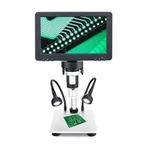Introduction to Testing Methods for Anemometers
The digital anemometer test includes testing of average wind speed and testing of turbulence components (turbulence of wind at 1-150KHz, different from fluctuations). The methods for testing average wind speed include thermal, ultrasonic, impeller, and drag tube methods
This method tests the resistance change generated by the sensor cooling due to wind when it is in an energized state, thereby testing the wind speed. Unable to obtain information on wind direction. In addition to being easy to carry and convenient, it has a high cost performance ratio and is widely adopted as a standard product for anemometers. Thermal anemometers use platinum wires, thermocouples, and semiconductors, but our company uses platinum coil wires. The material of platinum wire is physically stable. Therefore, it has advantages in long-term stability and temperature compensation.
The wind direction sensor of the photoelectric anemometer uses a low inertia light metal wind vane to respond to the wind direction, driving the coaxial encoder to rotate. This encoder is encoded in Gray code and scanned with photoelectrons, outputting electrical signals corresponding to the wind direction.
The photoelectric wind speed sensor adopts a low inertia wind cup, which rotates with the wind and drives the coaxial cutting disc to rotate. It uses photoelectron scanning to output a pulse string and outputs the corresponding pulse frequency value corresponding to the number of revolutions, making it easy to collect and process. High intensity, good starting, and in compliance with national meteorological measurement standards;
The wind direction sensor is equipped with an electronic compass that automatically locates the direction angle, which can be installed in fixed places or in mobile places (such as special vehicles, ships, drilling platforms, etc.). The rotary probe of the anemometer can be installed
The working principle of the rotary probe of the digital anemometer is based on converting the rotation into an electrical signal. First, it passes through a proximity sensing start to "count" the rotation of the rotary wheel and generate a pulse series. Then, it is converted and processed by the detector to obtain the speed value. The large-diameter probe of the anemometer (60mm, 100mm) is suitable for measuring turbulence at medium and small flow rates (such as at pipeline outlets). The small caliber probe of the anemometer is more suitable for measuring airflow with a cross-sectional area greater than 100 times that of the exploration head.
Positioning of Digital Anemometers in Air Flow
The correct adjustment position of the rotary probe of the anemometer is that the airflow direction is parallel to the rotary axis. When the probe is gently rotated in the airflow, the reading will change accordingly. When the reading reaches its maximum value, it indicates that the probe is in the correct measurement position. When measuring in a pipeline, the distance from the starting point of the straight part of the pipeline to the measurement point should be greater than 0XD, and the influence of turbulence on the thermal sensitive probe and pitot tube of the anemometer is relatively small.
Measurement of airflow velocity in pipelines using a digital anemometer
Practice has proven that the 16mm probe of the anemometer is the most widely used. Its size ensures good permeability and can withstand flow rates up to 60m/s. The measurement of airflow velocity in pipelines is one of the feasible measurement methods, and the indirect measurement regulation (grid measurement method) is applicable to air measurement.






